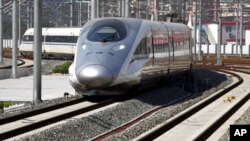This week China is showing-off its flagship high-speed rail route between its financial hub Shanghai and the capital Beijing. Travelling at 300 kilometers per hour, it radically cuts the travel times between the two cities, covering the roughly 1,300 kilometers in less than five hours.
Costly venture
It is no coincidence that China’s showcase high speed train link officially opens on Friday July 1st, the 90th anniversary of the Chinese Communist party.
And going by the first public test run for journalists Monday, China has every right to feel proud of a futuristic transport system that slashes the journey time between its two most important cities in half and delivers airline-like comfort.
The Ministry of Railways’s chief engineer He Hua Wu, told reporters minutes before train G1 pulled out of Beijing that the train-link was the “pride of China and Chinese people.” He said the Harmony express, which is named after Chinese President Hu Jintao’s Harmonious society slogan, is a gift to the ruling Communist Party.
However critics claim the $34 billion project built in just under 40 months is a vanity project that will not ease passenger congestion because the cheapest ticket at $50 is too expensive for most Chinese.
Concerns about waste, corruption and safety are also clouding the opening. Earlier this year the railway minister, Liu Zhijun, was sacked for corruption.
Officials have admitted nearly $30 million of funds for the line were embezzled or otherwise misused. The corruption has heightened safety fears over worries that shoddy construction materials were used in the project.
During the celebratory trial for the media, engineer He reacted with embarrassment when asked if corruption has blighted China’s high-speed railway network - the biggest in the world and one that is expanding fast.
He says the corruption problem has improved and that the rail line is safe.
His assistant then pushed this reporter aside and led the chief engineer quickly away.
Safety trumps speed
During the journey the train reached its optimum speed of 300 km per hour as untidy cities blighted by constructions sites, anonymous factories and intensely farmed countryside whizzed by.
The trains were initially expected to travel at 350 kilometers per hour but this was slashed to 300 because of safety concerns, fears over environmental impact and to save fuel so as to keep ticket prices down.
The project has have been built using a mix of international rail technology that the Chinese have adapted for their use. China’s ambitious construction plans mean they are now the world’s leading experts in high-speed railway construction.
The flagship train ride linking its political and financial hubs will not become known for its picturesque scenery. But to those who can afford a ticket it does offer a speedy alternative to the domestic flights which are notoriously delayed.






